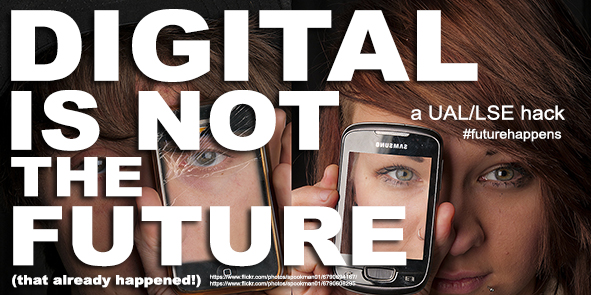Digital is not the future – Hacking the institution from the inside
Background
Within many higher education institutions, the patterns and responses of resistance to change make anything different from the norm forced into the position that has to justify ‘why?’ Debates about the potential of technology, the tensions of techno-determinism and the fears of replacement and redundancy have centred the discourse on service rather than pedagogy. The problem is that the genie is already out the bottle. There is no going back to chalkboards and overheads,we won’t be shutting off the internet any time soon. Technology and the digital are already integral to what we do but the presence of technology does not automatically equate to a shift in practice.
So, we came up with the idea of this hack. How do we change the discourse and empower people like us to actively shape teaching and learning at our institutions? What are the key messages, tools and strategies available that put the digital in the heart of the conversation and not as a freak show, an uncritical duplication of institutional norms or a fringe activity of the tech savvy?
The aim of this hack is to design collectively the solution to the problem. A problem that we all know exists but perhaps have never cracked. The problem of potential. The problem of resistance and acceptance. The problem of teaching and learning in the post-digital age. The problem of defining what a university is in the same.
An open document?
We have made a Loomio community, which open for anyone to edit. You can find it here, and registration is simple and easy!
This is a conversation that will be made better by involving more people. The aim of the community is to frame the discussions and debates we need to have at our institutions in order put innovation and the digital at the heart of the institutional approach to learning and teaching. There is a case to be made that institutionally, we have failed. ‘Traditional’ custom and practice is legitimised in the digital, whilst practice based innovation can be banished to the fringe or the grassroots. Techno-solutionism is equally legitimised, where ‘solutions in a box’ and services drive our activity; an activity that often replicates existing practice rather than transforming it. This widens the gap between ‘academic’ practice and the changing nature of learning in a digital era, masked by the procurement of new, and by implication, ‘innovative’ technologies
What do you have to do?
What we seek from the physical and online hacks is a form of radical pragmatism. You are in the room, because you are the institution, you are the senior management, you are the expert.
The rules of this hack are simple.
Rule 1: We are teaching and learning focused *and* institutionally committed
Rule 2: What we talk about here is institutionally/nationally agnostic
Rule 3: You are in the room with the decision makers. What we decide is critical to the future of our institutions. You are the institution
Rule 4: Despite the chatter, all the tech ‘works’ – the digital is here, we are digital institutions. Digital is not the innovation.
Rule 5: We are here to build not smash
Rule 6: You moan (rehearse systemic reasons why you can’t effect change – see Rule 3), you get no beer (wine, juice, love, peace, etc)
We have chosen 5 common scenarios which are often the catalyst for change in institutions. As we noted above, you are in the room with the new VC and you have 100 words in each of the scenarios below to effectively position what we do as a core part of the institution. Why is this going to make our institutional more successful/deliver the objectives/save my (the VCs) job? How do we demonstrate what we do will position the organisation effectively? How do we make sure we stay in the conversation and not be relegated to simply providing services aligned with other people’s strategies? Anyone who has been around the system for any length of time will recognise these scenarios and will have been through many of them. They are critical junctures at where momentum for change peaks.
Scenario 1
Strategic review of the institution and budget planning for 2020
Scenario 2
Institutional restructure because of a new VC
Scenario 3
Undertaking of an institution wide pedagogical redesign
Scenario 4
Responding to and implementing TEF
Scenario 5
Institutional response to poor NSS/student experience results
Write on the basis that you are pitching your responses to the above to the new VC and senior management.








[…] 1LSE Learning Technology & Innovation – Digital is not the future – A UAL/LSE online hack […]
[…] a homepage (that I only just discovered) and a Twitter hashtag #futurehappens (that I also wish I’d […]
[…] did a digital online hack event, Digital is not the future, to explore the idea of hacking the institution from the inside. Looking at shifting to active […]